INSTITUT SUPERIEUR D'ANTHROPOLOGIE
INSTITUTE OF ANTHROPOLOGY
ONLINE COURSES / COURS A DISTANCE
FALL TERM : OCTOBER 2015
REGISTER NOW
USA –  Pee Dee River - Underwater archaeologists on Tuesday plan to lift three heavy Civil War-era cannons from the waters of a South Carolina river where they have lain hidden for 150 years. Researchers from the University of South Carolina's Institute of Archaeology and Anthropology have been working since 2009 at the site of the Confederate Mars Bluff Navy Yard, located along the Pee Dee River where the cannons were found. Confederate forces dumped the cannons in the river and set the gunboat CSS Pee Dee on fire in 1865 so it wouldn't fall into the hands of advancing Union forces under Gen. William Tecumseh Sherman.The three cannons range in weight from 9,000 to 15,000 pounds and measure from 9 to 12 feet in length. One of the cannons, known as a smoothbore Dahlgren, was forged in Pennsylvania. It had been aboard the Union ship USS Southfield, but the cannon was captured following a ramming by a Confederate vessel . The other two weapons are known as Brooke rifled cannons and they were forged in Selma, Alabama .
Pee Dee River - Underwater archaeologists on Tuesday plan to lift three heavy Civil War-era cannons from the waters of a South Carolina river where they have lain hidden for 150 years. Researchers from the University of South Carolina's Institute of Archaeology and Anthropology have been working since 2009 at the site of the Confederate Mars Bluff Navy Yard, located along the Pee Dee River where the cannons were found. Confederate forces dumped the cannons in the river and set the gunboat CSS Pee Dee on fire in 1865 so it wouldn't fall into the hands of advancing Union forces under Gen. William Tecumseh Sherman.The three cannons range in weight from 9,000 to 15,000 pounds and measure from 9 to 12 feet in length. One of the cannons, known as a smoothbore Dahlgren, was forged in Pennsylvania. It had been aboard the Union ship USS Southfield, but the cannon was captured following a ramming by a Confederate vessel . The other two weapons are known as Brooke rifled cannons and they were forged in Selma, Alabama .
http://www.wsbtv.com/news/ap/georgia/archaeologists-to-pluck-3-civil-war-cannons-from-r/nnqSq/
PAKISTAN – Badin - Ancient artefacts and statues, reportedly centuries old, were discovered in Pakistan's Sindh province, the media reported on Friday. The ruins were unearthed in a dry riverbed in Badin district, Dawn online reported. "Many of the statues and artefacts are made of brass, copper and ivory," an official said. He added that after finding a few pieces, a group of locals started excavations in the area and unearthed more statues and artefacts."We used to discover similar artefacts from the area and we request the government to start proper archaeological excavations at the site," the official added. Local archaeologists and historians said this place was the site of an ancient city which was the capital for lower Sindh and Thar. "This region was of prime importance and centuries ago acted as the centre of various civilizations," said Mashkoor Phalkaro, a local historian and researcher. Another historian, Abu Bakar Shaikh said that the objects discovered suggest that they are centuries old when Dravidian culture was predominant in the region. He said that the artefacts discovered are of great importance and belong to the Buddhist religion.
https://in.news.yahoo.com//ancient-artefacts-statues-discovered-pakistan-115210840.html
RUSSIE – 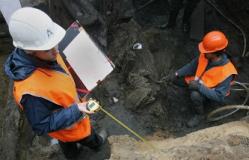 Kerch Strait - An archaeological diving team has discovered an 18th century Turkish ship, sunk by prominent Russian naval commander, Admiral Fyodor Ushakov, in the Kerch Strait connecting the Black Sea and the Sea of Azov. "The ship presumably dating back to the 18th century has been found and examined," Viktor Vakhoneev, deputy head of the Black Sea Underwater Research Center told TASS. "It may be one of the ships drowned by Admiral Ushakov during the famous naval Battle of Kerch Strait in 1790 against the Ottoman Empire." The Kerch Battle took place on July 19, 1790 near Kerch, Crimea, and was a slight victory for Imperial Russia over the Ottoman Empire during the Russo-Turkish War of 1787-1792. Admiral Ushakov was defending Crimea from Turkish conquerors, drowning several enemy’s ships, one of which was found recently. According to Vakhoneev, the ship was found in a good condition and the research work will continue next year.
Kerch Strait - An archaeological diving team has discovered an 18th century Turkish ship, sunk by prominent Russian naval commander, Admiral Fyodor Ushakov, in the Kerch Strait connecting the Black Sea and the Sea of Azov. "The ship presumably dating back to the 18th century has been found and examined," Viktor Vakhoneev, deputy head of the Black Sea Underwater Research Center told TASS. "It may be one of the ships drowned by Admiral Ushakov during the famous naval Battle of Kerch Strait in 1790 against the Ottoman Empire." The Kerch Battle took place on July 19, 1790 near Kerch, Crimea, and was a slight victory for Imperial Russia over the Ottoman Empire during the Russo-Turkish War of 1787-1792. Admiral Ushakov was defending Crimea from Turkish conquerors, drowning several enemy’s ships, one of which was found recently. According to Vakhoneev, the ship was found in a good condition and the research work will continue next year.
http://tass.ru/en/society/824627?
TURQUIE – 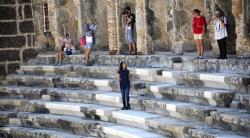 Aspendos - A new case has been added to a growing number of botched historic restoration projects in Turkey, with the renowned amphitheater in the classical town of Aspendos, located in modern day Antalya province, being restored with white marble instead of the original gray.
Aspendos - A new case has been added to a growing number of botched historic restoration projects in Turkey, with the renowned amphitheater in the classical town of Aspendos, located in modern day Antalya province, being restored with white marble instead of the original gray.
http://arts-entertainment.bgnnews.com/kitchen-grade-marble-used-in-the-restoration-of-ancient-city-of-aspendos-haberi/9791?
ITALIE – 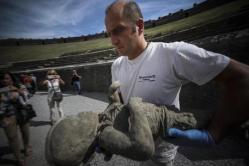 Pompei - At least some of Pompeii's residents had perfect teeth thanks to a healthy low-sugar diet, researchers said Tuesday after examining CAT scans on 30 chalk casts of the victims of the 79 AD eruption that buried the ancient Roman city. The 30 sets of teeth were unblemished apart from some wear and tear caused by their habit of cutting or snapping objects with their jaws, the researchers said. The team sent in by the Pompeii superintendency had to use special 16-layer scanning equipment provided by Philips SpA Healthcare because of the density of the casts."One of the problems we encountered was the density of chalk used for the cast technique," said Superintendent Massimo Osanna. "It is a density similar to bones, that's why we had to use the 16-layer CAT technology". The project sees archaeologists, anthropologists, radiologists, dental experts and engineers working together on the laser-scanning research. The aim is to chart the lifestyles, jobs, and social class of the person hidden in the cast. The team has already found that Pompeians' bones were damaged because of the excessive presence of fluorine in the Vesuvian water table.
Pompei - At least some of Pompeii's residents had perfect teeth thanks to a healthy low-sugar diet, researchers said Tuesday after examining CAT scans on 30 chalk casts of the victims of the 79 AD eruption that buried the ancient Roman city. The 30 sets of teeth were unblemished apart from some wear and tear caused by their habit of cutting or snapping objects with their jaws, the researchers said. The team sent in by the Pompeii superintendency had to use special 16-layer scanning equipment provided by Philips SpA Healthcare because of the density of the casts."One of the problems we encountered was the density of chalk used for the cast technique," said Superintendent Massimo Osanna. "It is a density similar to bones, that's why we had to use the 16-layer CAT technology". The project sees archaeologists, anthropologists, radiologists, dental experts and engineers working together on the laser-scanning research. The aim is to chart the lifestyles, jobs, and social class of the person hidden in the cast. The team has already found that Pompeians' bones were damaged because of the excessive presence of fluorine in the Vesuvian water table.
http://www.ansa.it/english/news/lifestyle/arts/2015/09/29/pompeii-residents-had-perfect-teeth_b0a89c56-b0c7-43b4-be48-acd72efd7c63.html?
IRAN – 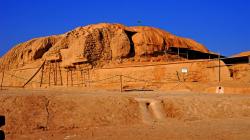 Sialk - The Sialk Site is located on the road from Kashan to Fin gardens. The site consists of two mounds located 600 meters away from each other. The remains of two graveyards (necropolis), adjacent to the hills, have also been excavated. Excavations on the northern mound, dating back to 7,500 years, indicate that they were abandoned 6,100 years ago, while the southern hillock was still inhabited. The fourth ziggurat of Iran has also been discovered in the excavations. This ziggurat was built approximately 5,000-4,250 years ago. The cemeteries, which date back to 3,500 and 3,000 years ago, belong to the Median era. This site is one of the few human settlements belonging to 7,500 years ago. The burial ceremonies in this ancient city are different from other ancient cities in Iran. Many of the items found in Sialk were excavated from the necropolis, irantravelingcenter.com reported. Sialk is one of four ziggurats built by the Elamite civilization. The other three are: Choqa Zanbil (1,250 BCE), Susa ziggurat (1,800 BCE), and Haft Teppeh (1,375 BCE), all Khuzestan. Teppe Sialk (Sialk Moundl) was first excavated by a team of European archeologists headed by French Archeologist Roman Ghirshman in the 1930s. But like the thousands of other ancient items, the treasures excavated here eventually found their way to museums of Europe, America and private collectors. The Sialk ziggurat has three floors. The ziggurat itself was built in 2,900 BCE. Sialk, and the entire area around it, is thought to have first originated as a result of the pristine large water sources nearby that still run today. Soleymanieh Spring has been bringing water to this area from nearby mountains for thousands of years.
Sialk - The Sialk Site is located on the road from Kashan to Fin gardens. The site consists of two mounds located 600 meters away from each other. The remains of two graveyards (necropolis), adjacent to the hills, have also been excavated. Excavations on the northern mound, dating back to 7,500 years, indicate that they were abandoned 6,100 years ago, while the southern hillock was still inhabited. The fourth ziggurat of Iran has also been discovered in the excavations. This ziggurat was built approximately 5,000-4,250 years ago. The cemeteries, which date back to 3,500 and 3,000 years ago, belong to the Median era. This site is one of the few human settlements belonging to 7,500 years ago. The burial ceremonies in this ancient city are different from other ancient cities in Iran. Many of the items found in Sialk were excavated from the necropolis, irantravelingcenter.com reported. Sialk is one of four ziggurats built by the Elamite civilization. The other three are: Choqa Zanbil (1,250 BCE), Susa ziggurat (1,800 BCE), and Haft Teppeh (1,375 BCE), all Khuzestan. Teppe Sialk (Sialk Moundl) was first excavated by a team of European archeologists headed by French Archeologist Roman Ghirshman in the 1930s. But like the thousands of other ancient items, the treasures excavated here eventually found their way to museums of Europe, America and private collectors. The Sialk ziggurat has three floors. The ziggurat itself was built in 2,900 BCE. Sialk, and the entire area around it, is thought to have first originated as a result of the pristine large water sources nearby that still run today. Soleymanieh Spring has been bringing water to this area from nearby mountains for thousands of years.
http://www.iran-daily.com/News/127906.html?
CHINE - Dandong No.1" - "Dandong No.1", a shipwreck discovered last year near Dandong Port, has been confirmed as cruiser Zhiyuan, one of the warships of the Beiyang Fleet sunk by the Japanese navy during the first Sino-Japanese War 121 years ago. Zhou Chunshui, head of an archeological team from the National Center of Underwater Cultural Heritage, told Xinhua that they have salvaged more than 100 items from the wreck during the past two months. "From these items, we can confirm that this is the wreck of the Zhiyuan," said Zhou, who added that two Chinese characters Zhi and yuan were found on a porcelain plate. Zhou said the Zhiyuan and its sister vessel Jingyuan were designed and manufactured by a UK firm, with their tableware specially made. A plate from the Jingyuan was also found printed with the same font. The wreckage of the warship was found during underwater exploration for port construction last year. Codenamed "Dandong No. 1", the intact 50-meter hull is located 10 nautical miles southwest of Dandong Port, Liaoning Province. The inside of the 1,600-tonne ship has been badly damaged. Archeologists found fragments of ordinance inside. The Zhiyuan was one of the modern warships in the Qing Dynasty Beiyang Fleet, defeated by the Japanese navy in the Battle of Yellow Sea on Sept. 17, 1894. Records show that captain Deng Shichang refused to leave the ship, despite it being severely crippled, on fire and sinking.
http://news.xinhuanet.com/english/2015-09/29/c_134672127.htm?
TURQUIE -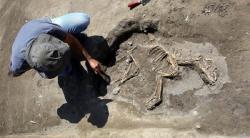 Van - A recent archeological excavation into an Urartu civilization site has uncovered the 3,000-year-old skeletal remains of a dog buried inside an ancient home. Though they have been working at sites in the vicinity of Van Castle for six years now, the team was still surprised when they discovered a dog skeleton – estimated to be at least 3,000 years old – buried under the foundation of an ancient house. “We’ve found such examples before in necropolis areas around the Van basin such as at Yonca Hill. But this is a very interesting and unusual case. This is a case of burying a dog inside a building,” Konyar says, noting this is the first time his team has ever seen such a thing.The finding reveals the high value that the Urartu gave to their sheep dogs, says Konyar. “This shows the Urartu people’s love of animals. We’re talking about a civilization that was engaged in sheep and goat farming. We see dogs were very valued here. Maybe this was a very valuable dog, hence why it was buried inside.” Konyar explains that in other archeological sites – such as Turkey’s Çatalhöyük, where a human settlement existed from roughly 7,500 to 5,700 BCE – early people would often bury their close relatives directly under the ground where they lived. “And here we see that the Urartu buried an animal. What an interesting connection.” The dig at the current site began about a month ago, with the intention of unearthing clues about Urartu civilian architecture. Konyar notes that the site is an area where elite classes of the ancient society once lived, as evidenced by the clay tablets and ornamental items that have been recovered.
Van - A recent archeological excavation into an Urartu civilization site has uncovered the 3,000-year-old skeletal remains of a dog buried inside an ancient home. Though they have been working at sites in the vicinity of Van Castle for six years now, the team was still surprised when they discovered a dog skeleton – estimated to be at least 3,000 years old – buried under the foundation of an ancient house. “We’ve found such examples before in necropolis areas around the Van basin such as at Yonca Hill. But this is a very interesting and unusual case. This is a case of burying a dog inside a building,” Konyar says, noting this is the first time his team has ever seen such a thing.The finding reveals the high value that the Urartu gave to their sheep dogs, says Konyar. “This shows the Urartu people’s love of animals. We’re talking about a civilization that was engaged in sheep and goat farming. We see dogs were very valued here. Maybe this was a very valuable dog, hence why it was buried inside.” Konyar explains that in other archeological sites – such as Turkey’s Çatalhöyük, where a human settlement existed from roughly 7,500 to 5,700 BCE – early people would often bury their close relatives directly under the ground where they lived. “And here we see that the Urartu buried an animal. What an interesting connection.” The dig at the current site began about a month ago, with the intention of unearthing clues about Urartu civilian architecture. Konyar notes that the site is an area where elite classes of the ancient society once lived, as evidenced by the clay tablets and ornamental items that have been recovered.
http://arts-entertainment.bgnnews.com/3000-year-old-dog-skeleton-found-in-urartu-dig-in-van-turkey-haberi/9776?